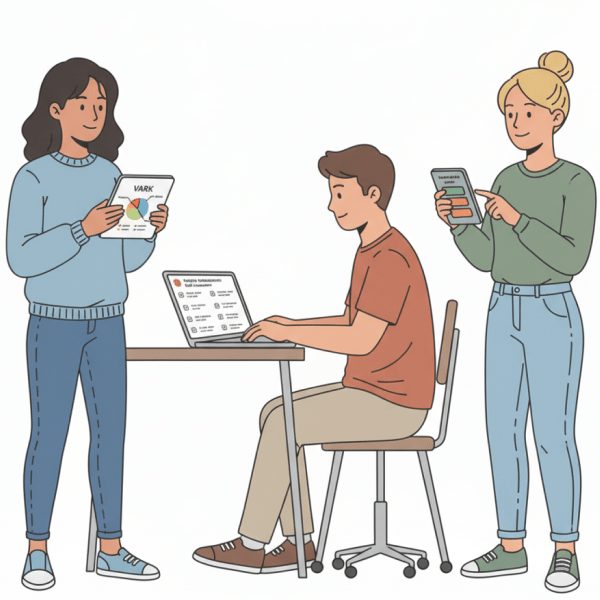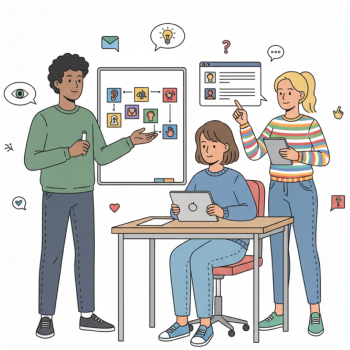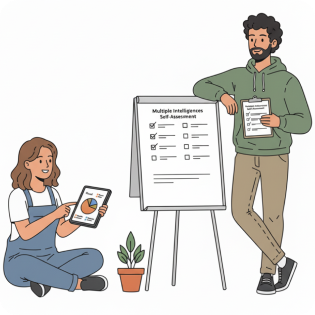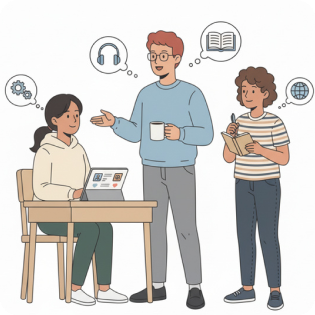
Mastering Study Preferences With the VARK Approach
The VARK approach shines a light on how individuals prefer to engage with information through four sensory channels: Visual, Aural, Read/Write, and Kinesthetic. Rather than boxing people into rigid categories, the model reveals patterns that help learners choose strategies that feel natural and effective. When you understand the way you absorb and recall details best, you can tune note-taking, lesson pacing, and review techniques to match your brain’s favored pathways. That alignment reduces friction, speeds comprehension, and turns practice into progress.
Boost Study Skills
Educators appreciate that this framework promotes clarity around study behaviors without oversimplifying human cognition. In many programs, the VARK assessment functions as a structured prompt for reflection and discussion within study groups. Instead of asking students to change who they are, the model encourages them to adjust how they approach complex texts, demonstrations, and practice tasks in purposeful ways.

From Assessment to Action: Optimizing Workflows
Organizations value how the model translates into action, from onboarding plans to professional development workshops. Teams often begin by mapping tasks to modalities so that workflows and resources match the job’s demands more precisely than a generic learning assessment would allow. That operational fit cuts down on rework, grows confidence, and builds a shared language for feedback across departments.

Because preferences can vary across contexts, it is wise to revisit results over time and ask how they play out in different subjects. Coaches and advisors can make these conversations concrete by pairing strategy menus with class objectives, turning reflection into a practical learner assessment that evolves during the semester. That cycle keeps the model dynamic, relevant, and anchored in authentic performance.
How the Learning Style Connects to Other Theories
When comparing lenses, it helps to separate quick diagnostics from deeper profile methods and ask how each will inform instruction tomorrow morning. In many schools, faculty pair modality insights with a broader multiple intelligences assessment so that lesson plans balance strengths without diluting rigor. That blending avoids false dichotomies and steers attention toward interventions that change outcomes rather than labels.
| Modality | Best-Fit Strategies | Instructor Cues |
| Visual | Concept maps, annotated diagrams, color-coded steps | Show workflows, highlight relationships, use spatial layouts |
| Aural | Explainer talks, peer teaching, recorded summaries | Think aloud, vary tone, seed discussion prompts |
| Read/Write | Structured notes, glossaries, synthesis paragraphs | Provide prompts, outlines, and clear textual exemplars |
| Kinesthetic | Simulations, labs, role plays, hands-on checklists | Demonstrate procedures, stage practice, iterate quickly |
Because institutions have diverse goals, course designers often triangulate modalities with broader style frameworks to guide scaffolding. Many program reviews integrate findings from a campus-wide learning styles assessment to confirm that the curriculum supports varied paths toward the same rigorous standards. That alignment keeps equity and excellence moving in tandem throughout a program.

For broader talent mapping, leaders sometimes look at creativity, logic, and practical problem-solving side by side. In those cases, it can be useful to pair a modality inventory with an assessment of multiple intelligences to illuminate complementary strengths across a cohort. That synthesis enables better group composition, mentoring matches, and project assignments across divisions.
- 1Map course objectives to modality-friendly strategies students can try this week.
- 2Offer templates for notes, diagrams, reflection logs, and checklists to reduce friction.
- 3Design quick feedback loops so learners can refine tactics after each assignment.
- 4Provide example artifacts that illustrate what “good” looks like in each modality.
Maximize Study Results
Another practical gain appears during independent study, where small changes compound over time. Students who discover concrete tactics via a learning style assessment often streamline their prep routines and reclaim hours each week. Those reclaimed hours can then be invested in spaced practice and self-testing that deepen long-term retention.

Smarter Training With Learning Styles Assessment
Organizations building robust training pipelines find similar wins in onboarding and upskilling efforts. After teams explore results from a VARK learning assessment, managers can thread modality-friendly resources into playbooks and job aids. This leads to faster ramp times, fewer errors, and stronger confidence among new hires in demanding roles. Program evaluators also track spillover effects such as peer coaching and shared strategy libraries. Across departments, leaders reference cumulative findings from periodic learning assessments to fine-tune support services and resource allocation. Over a year, these incremental improvements add up to measurable gains in satisfaction and performance metrics.

Choosing Instruments and Putting Insights to Work
Before administering an inventory at scale, review reliability evidence, scoring transparency, and accessibility. Many institutions compile a shortlist of validated learning style assessment tools and pilot them with a small group prior to full rollout. That pilot phase reveals where instructions need refinement and where scaffolding will have the greatest impact.
Advisors can maximize uptake by building reflective prompts into coaching conversations. A short debrief tied to a learning style and self-assessment helps translate abstract preferences into practical study behaviors. That translation step converts awareness into durable, high-impact routines. Budget constraints need not become barriers, especially for entry-level exploration and classroom discussion. Many educators start the semester with a classroom-friendly learning style assessment free option and pair it with strategy menus. Even a brief reflective snapshot can spark powerful conversations and measurable improvements in study plans.
Kolb Learning Insights
Some programs weave modality insights with experience-based cycles to enrich project-based learning. In these cases, mentors might integrate reflections inspired by a Kolb learning style assessment to pace activities from concrete doing to thoughtful abstraction. That pairing keeps momentum high while deepening conceptual understanding through deliberate iteration.

Apply Learning Styles on the Job
Adult education introduces variables such as work schedules, caregiving responsibilities, and accumulated expertise. Course designers support relevancy and persistence by blending case studies, demonstrations, and concise readings guided by a learning styles assessment for adults. With that alignment, learners can practice skills immediately on the job and return to class with sharper questions.
Frequently Asked Questions
- Is VARK a label or a guide?
It is best used as a practical guide to select strategies, not as a fixed label. Preferences are context-sensitive, so people benefit from trying multiple approaches and keeping what works. As courses change, revisiting results helps keep habits aligned with new demands and goals.
- Can I have more than one strong modality?
Yes, many individuals show blended preferences that shift by task, subject, or time pressure. The most effective study plans embrace that variety and let the task dictate the tool. Over time, reflection turns this flexibility into a reliable, personalized playbook.
- How should teachers use results without increasing workload?
Pick two or three high-yield strategies per unit and embed them into existing lessons, rather than creating parallel tracks. Provide reusable templates and examples so differentiation scales gracefully across classes. Quick check-ins after assignments can sustain momentum without adding heavy grading.
- What about broader cognitive strengths beyond sensory channels?
Some educators complement modality insights with a thoughtful multiple intelligences self assessment to inform enrichment and project roles. When combined carefully, these perspectives highlight complementary strengths across a group. The key is to keep interventions concrete, actionable, and tied to current learning objectives.
- How do learners turn insight into daily habits?
Translate each preference into two or three tactics you can use this week, then track what sticks. For example, create annotated diagrams for dense readings or record short verbal summaries after labs. Review your notes weekly and refine the routine as your courses evolve.
The Latest News
-
![A Complete Guide to the VARK Model and Personalized Learning Preferences]() A Complete Guide to the VARK Model and Personalized Learning Preferences Take Learning Style Assessment Online Get Started What VARK Is and Why Learning Preferences Matter The VARK framework classifies how individuals tend to absorb, process, and recall information across four modalities: Visual, Aural, Read/Write, and Kinesthetic. Instead of c...
A Complete Guide to the VARK Model and Personalized Learning Preferences Take Learning Style Assessment Online Get Started What VARK Is and Why Learning Preferences Matter The VARK framework classifies how individuals tend to absorb, process, and recall information across four modalities: Visual, Aural, Read/Write, and Kinesthetic. Instead of c... - 3 November, 2025
-
![Understanding and Using Multiple Intelligences: A Complete Assessment Guide]() Understanding and Using Multiple Intelligences: A Complete Assessment Guide Take Learning Style Assessment Online Get Started Foundations of Multiple Intelligences Test Human capability is a mosaic, not a single metric, and this insight sits at the heart of the multiple intelligences perspective. Instead of ranking people on a narrow academic scal...
Understanding and Using Multiple Intelligences: A Complete Assessment Guide Take Learning Style Assessment Online Get Started Foundations of Multiple Intelligences Test Human capability is a mosaic, not a single metric, and this insight sits at the heart of the multiple intelligences perspective. Instead of ranking people on a narrow academic scal... - 31 October, 2025
-
![The Complete Guide to Understanding and Using Learning Style Assessments]() The Complete Guide to Understanding and Using Learning Style Assessments Take Learning Style Assessment Online Get Started Why Understanding Your Learning Style Matters Most people study harder when they could study smarter, and that difference often stems from knowing how the brain prefers to take in, transform, and remember information. A tho...
The Complete Guide to Understanding and Using Learning Style Assessments Take Learning Style Assessment Online Get Started Why Understanding Your Learning Style Matters Most people study harder when they could study smarter, and that difference often stems from knowing how the brain prefers to take in, transform, and remember information. A tho... - 30 October, 2025
Please Note
This website (learning-style-assessment.com) is not an official representative, creator or developer of this application, or product. All the copyrighted materials belong to their respective owners. All the content on this website is used for educational and informative purposes only.



